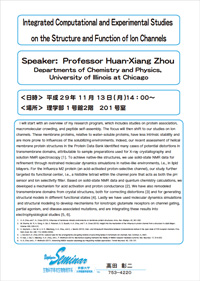This notice is to inform you of an upcoming seminar. All students and researchers of The Graduate School and Faculty of Science are welcomed to attend. No registration is required.
Professor Huan-Xiang Zhou
Departments of Chemistry and Physics, University of Illinois at Chicago
Title: Integrated Computational and Experimental Studies on the Structure and Function of Ion Channels
| Date/Time | Mon 13 Nov 2017, 14:00 |
|---|---|
| Venue | Graduate School of Science Bldg. No. 1 (Kyoto U, North Campus) 2nd Floor, Room #201 |
| Registration | Not required |
| Language | English |
| Host | Dept Biophysics, Div Biology, Grad School Science, Kyoto University |
| Contact | Shoji Takada 075-753-4220 |
Abstract
I will start with an overview of my research program, which includes studies on protein association, macromolecular crowding, and peptide self-assembly. The focus will then shift to our studies on ion channels. These membrane proteins, relative to water-soluble proteins, have less intrinsic stability and are more prone to influences of the solubilizing environments. Indeed, our recent assessment of helical membrane protein structures in the Protein Data Bank identified many cases of potential distortions in transmembrane domains, attributable to sample preparations used for X-ray crystallography and solution NMR spectroscopy [1]. To achieve native-like structures, we use solid-state NMR data for refinement through restrained molecular dynamics simulations in native-like environments, i.e., in lipid bilayers. For the Influenza M2 protein (an acid-activated proton-selective channel), our study further targeted its functional center, i.e., a histidine tetrad within the channel pore that acts as both the pH sensor and ion selectivity filter. Based on solid-state NMR data and quantum chemistry calculations, we developed a mechanism for acid activation and proton conductance [2]. We have also remodeled transmembrane domains from crystal structures, both for correcting distortions [3] and for generating structural models in different functional states [4]. Lastly we have used molecular dynamics simulations and structural modeling to develop mechanisms for ionotropic glutamate receptors on channel gating, partial agonism, and disease-associated mutations, and are integrating these results into electrophysiological studies [5, 6].
1. H.-X. Zhou and T. A. Cross (2013). Influences of membrane mimetic environments on membrane protein structures. Annu. Rev. Biophys. 42, 361-392.
2. M. Sharma, M. Yi, H. Dong, H. Qin, E. Peterson, D. D. Busath, H.-X. Zhou, and T. A. Cross (2010). Insight into the mechanism of the Influenza A proton channel from a structure in a lipid bilayer.
Science 330, 509-512.
3. G. Heymann, J. Dai, M. Li, S. D. Silberberg, H.-X. Zhou, and K. J. Swartz (2013). Inter- and intrasubunit interactions between transmembrane helices in the open state of P2X receptor channels. Proc.
Natl. Acad. Sci. USA 110, E4045-E4054.
4. J. Dai and H.-X. Zhou (2014). General rules for the arrangements and gating motions of pore-lining helices in homomeric ion channels. Nat. Commun. 5, 4641.
5. R. Kazi, J. Dai, C. Sweeney, H.-X. Zhou, and L. P. Wollmuth (2014). Mechanical coupling maintains the fidelity of NMDA receptor-mediated currents. Nat. Neurosci. 17, 914-922.
6. H.-X. Zhou and L. P. Wollmuth (2017). Advancing NMDA receptor physiology by integrating multiple approaches. Trends Neurosci. 40, 129-137




